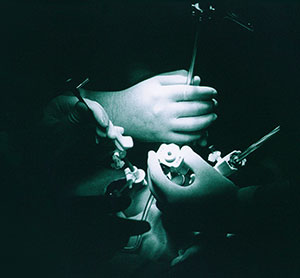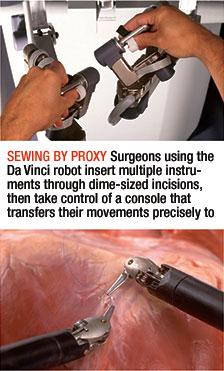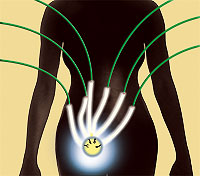The Measure of Minimally Invasive Surgery
By Kathleen Yount
 Good surgeons are always thinking about the best way to get under your skin. After all, it’s their job to know the body inside and out. They spend their days and nights at work on the fabulous human machine, using fingers and instruments to fix the broken parts inside.
Good surgeons are always thinking about the best way to get under your skin. After all, it’s their job to know the body inside and out. They spend their days and nights at work on the fabulous human machine, using fingers and instruments to fix the broken parts inside.
These artisans of the body need tools—and when the tools change, surgeons must hone their craft to match. In the last two decades, the phenomenon of “minimally invasive” surgery—laparoscopy, endoscopy, arthroscopy—has given rise to a new set of tools that have wrought a sea change in almost every specialty in the field.
The Boon of Downsizing
Minimally invasive surgeries offer big benefits. Tiny instruments need only tiny openings—which means less cutting, less bleeding, and less recovery time. Then there are the cosmetic perks: smaller incisions and decreased infection rates lead to fewer scars.
Minimally invasive techniques also give new hope to patients who wouldn’t have been considered to be surgical candidates in the past. Consider bariatric surgery—the only treatment shown to yield long-term weight loss for the morbidly obese. Traditional (or “open”) bariatric surgery can be quite risky, especially given the already compromised health of a morbidly obese patient. However, with today’s laparoscopic gastric bypass, morbidly obese patients can avoid large incisions, reducing their rates of infection, sepsis, and leakage.
These upsides might make minimally invasive surgery sound like a perfect solution for every procedure and every surgeon. But there are some caveats. Even though minimally invasive techniques are easier on patients, they are often harder on surgeons. The skills required can be difficult to master, and surgeons agree that the techniques are not suited to every task. To ensure a patient’s best outcome, experts say, these tools must always be wielded with utmost discretion.
Toughened Training
 Picture yourself climbing a long flight of stairs. Now imagine that a patch suddenly appears over one of your eyes. “You’re going to want to be hanging onto the rail,” says UAB gastrointestinal surgeon Ronald Clements, M.D. That’s because your odds of stumbling midflight have gone up dramatically. And don’t even think about wearing that patch while trying to drive a car.
Picture yourself climbing a long flight of stairs. Now imagine that a patch suddenly appears over one of your eyes. “You’re going to want to be hanging onto the rail,” says UAB gastrointestinal surgeon Ronald Clements, M.D. That’s because your odds of stumbling midflight have gone up dramatically. And don’t even think about wearing that patch while trying to drive a car.
“You have no depth perception with one eye,” says Clements. “And looking at an object on a video screen”—the way a surgeon sees his work field during minimally invasive procedures—“is the same as looking at it with one eye.”
Thus a new set of skills has been added to the surgical repertoire, requiring new training. Clements, who directs UAB’s Alabama Institute for Minimally Invasive Surgery, says that two-dimensional vision is just one of the challenges of training surgeons. “In traditional operations, you put your hands in, you feel things, you have that manual dexterity,” he says. “So much of the experience is different with laparoscopy. You can’t feel things with your fingers; you can’t see things in three dimensions. You’re standing beside a patient with instruments that go into the body, but your head is looking up at a TV screen, and your hands never touch the patient.”
Clements notes that people who grew up in the age of video games have an advantage in learning these new techniques—even if their expertise was originally honed for the purposes of leaping over toothy gnomes or laying waste to cities in virtual hand-to-hand combat. But for many surgeons, these skills require determination to learn and deep devotion to master.
Up Close—Very Close
Some surgeons are drawn to minimally invasive techniques, even going so far—like Clements—as to pursue fellowships that are devoted to minimally invasive procedures. Those who do gravitate to minimally invasive surgery often find that it’s almost easier to do their work laparoscopically than in an open field.
|
Gynecologic cancer surgeon Warner Huh, M.D., who was the first surgeon in Alabama to perform a radical hysterectomy using the Da Vinci surgical robot, says that minimally invasive surgery has revolutionized his practice. “I’m the minimally invasive guy now, for my division and my department,” he says. Huh estimates that roughly half of his colleagues perform minimally invasive surgeries extensively, and his division has seen a 500 percent increase in those procedures in the last decade.
Huh acknowledges that switching to minimally invasive techniques wasn’t a natural transition. “It was substantially harder than I thought,” he says. “There’s a steeper learning curve than for open procedures, and it takes a lot of experience to get comfortable. But once you are comfortable, they’re appreciably easier to perform.” So much easier that he prefers these techniques for most of his cases.
Huh explains that the very things that make minimally invasive techniques hard to learn ultimately make them perfect for certain applications: “You’re operating in a completely different plane, so you get a different perspective.” This new perspective, even though it is two-dimensional, brings the surgeon’s eyes from three feet above the patient to something closer to five inches. “The kind of visualization you can get with this type of procedure is vastly underappreciated,” says Huh.
A super-closeup view can be tremendously helpful in certain scenarios. For example, obese patients who need hysterectomies present a significant technical challenge for surgeons. “It can be a two- to three-foot distance just from the abdominal wall to the uterus,” says Huh. “That distance is obviated with laparoscopy.”
In fact, he says, it has changed the way he does open procedures, as well. “I’ve been able to see things via laparoscopy that I’d never have been able to see in an open procedure. It has forced me to revisit how I do my open surgery.”
Scoping Takes Its Toll
All surgeons, regardless of the techniques they use, must pay a certain physical price for their art, and this is especially true for those conducting minimally invasive surgeries.
“I do three or four laparoscopic procedures and I’m sore—in places that I shouldn’t be sore,” says Huh. “You have to really contort your body to use this equipment.” In fact, in a discipline where rates of disability are already high, minimally invasive techniques are likely to make the problem worse. “Insurance companies have actually capped long-term disability for surgeons, because they were claiming it at such a high rate,” says Huh.
 “There’s a mantra I repeat to my residents: Someone always pays a price, in terms of discomfort,” he continues. “It’s either going to be the surgeon or the patient. And in minimally invasive surgeries, it’s the surgeon, because these procedures are definitely not ergonomic.”
“There’s a mantra I repeat to my residents: Someone always pays a price, in terms of discomfort,” he continues. “It’s either going to be the surgeon or the patient. And in minimally invasive surgeries, it’s the surgeon, because these procedures are definitely not ergonomic.”
Still, Huh says, he wouldn’t trade the tools for comfort’s sake. “I get a lot of personal satisfaction out of allowing my patients to go home within a day of their surgeries,” he says, “and from being able to offer services to the morbidly obese, when just two or three years ago many of these surgeries were not available to them.”
Huh notes that in his field, laparoscopy is a particular blessing. “From the women’s health perspective, it is a big advantage. Many of my patients work, take care of their families, run their households. Patients used to be out for two months after hysterectomies, and now they’re only out for half that time. To be able to get patients back in action faster is really rewarding for me.”
Patient-friendly procedures are increasingly important, because medicine is becoming a more consumer-driven field, says Huh. “And we have very savvy patients in the Birmingham area. They go online; they do the research. We get a lot of patient-driven referrals—they say, ‘I decided to have a hysterectomy, and my doctor was going to do an open procedure, but I want a laparoscopic one.’”
The Instruments May Change . . .
As appealing as these new techniques might be, sometimes they have to take a back seat to the disease in question. “When a patient has cancer, his attitude is usually, ‘Doc, cut me open from chin to toe if that’s what it takes,’” says Martin Heslin, M.D., a surgeon who specializes in gastrointestinal cancers. In the types of cases he sees, Heslin says, the issue is not just whether the surgeon has the appropriate training for laparoscopy (see “It’s All in the Technique”)—the operation has to do its intended job to treat the disease.
Both Huh and Heslin often use laparoscopy and endoscopy to remove tumors and perform biopsies—Heslin says that at least half his practice consists of minimally invasive techniques. But he also says it’s important that patients trust the judgment of the surgeon to select the best type of technique to treat a malignancy.
|
With colon cancers, for example, it’s actually a close call as to whether laparoscopy offers a significant benefit over traditional techniques. A large, randomized trial of laparoscopic versus open colon cancer operations showed that there was no difference in cancer outcomes. And the difference in length of hospital stay was less than a day. “That’s because what we’re waiting for in order to send the patient home is return of bowel function,” says Heslin—“and that is a separate function from incision healing.”
Heslin notes that even a difference of less than a day can mean a lot to a patient’s comfort. It also can add up to real dollars saved in the expense of hospital care. However, the pocket that benefits and the pocket that feels the pinch—patient, hospital, or insurance company—can vary. “The up-front costs for a hospital to purchase and maintain the equipment we need for these surgeries is quite high,” he says. “If a hospital and an insurance company agree on reimbursement based on days of stay, as opposed to a flat reimbursement based on diagnosis and procedure, it’s hardly helping to offset the cost of the patient’s care.”
…But the Body Remains the Same
Heslin says that in his practice, laparoscopy is extremely useful in diagnosing dangerous micrometastatic diseases in the abdomen that can’t be imaged otherwise. “You save patients a big incision,” he explains. “They essentially get over the operation in one week instead of six to eight,” which could be particularly helpful in speeding up the treatment process if a malignancy is detected. “In that scenario, there are enormous benefits in terms of length of stay and return to normal life.”
 But Heslin says the most important thing to remember about minimally invasive surgeries is that while the techniques are changing, the disease, the body, and the surgical agenda are not. “These techniques give us an opportunity to perform the same operation with smaller holes,” he notes. “But they don’t change physiology, and they don’t change anatomy.” And since anatomy prevents surgeons from creating as much room in the pelvis as they can in the abdomen, many colon tumors and most all rectal tumors are not good candidates for laparoscopy.
But Heslin says the most important thing to remember about minimally invasive surgeries is that while the techniques are changing, the disease, the body, and the surgical agenda are not. “These techniques give us an opportunity to perform the same operation with smaller holes,” he notes. “But they don’t change physiology, and they don’t change anatomy.” And since anatomy prevents surgeons from creating as much room in the pelvis as they can in the abdomen, many colon tumors and most all rectal tumors are not good candidates for laparoscopy.
“It depends on tumor size and location relative to other structures,” Heslin says. “You need to make an incision big enough to get the tumor out without rupturing it. You need to be able to get an adequate harvest of lymph nodes.”
“My goal is cancer cure,” he emphasizes. “If I can do it with smaller holes, that’s terrific.”
Though some situations will always necessitate open procedures, Heslin echoes Clements in this prognosis: Many minimally invasive surgeries that are difficult for today’s surgeons to master will become standard as younger generations begin to practice medicine. “My son’s hands are essentially welded to his XBox controller,” he says. “I ask him how he makes some back double-flip layout turn in his skateboarding game, and he says, ‘I don’t know.’ I say, ‘Well what did you do?’ and he says, ‘I just did it.’” As Heslin puts it, talking about some of the current robotic techniques, “My eight-year-old could do that surgery.”
Judgment Calls
|
He exaggerates, of course. But what prevents kids from donning scrubs and climbing surgical stools is certainly not lack of physical capability. According to gastrointestinal surgeon Mary Hawn, M.D., co-director for education in the Alabama Institute for Minimally Invasive Surgery, what’s lacking is actually the most important tool a surgeon has: judgment.
In procedures where a surgeon works by remote in any capacity, Hawn says, he or she needs to learn certain technical judgments—“how to use visual cues about how the tissue is responding to what they’re doing to it, for example, or how to evaluate the resistance they are meeting in relation to the force they’re applying.” But more important than the technical interpretations, she says, is the wisdom “to know when to open, and when not to. We may start some things laparoscopically and not be able to complete them that way. You have to have good judgment to know when it’s no longer safe to proceed with what you’re doing.”
Or, as Heslin emphasizes, to know when not to start down that route at all. In other words, the Star Trek fantasy of performing every operation sans scalpel is not on the horizon—not even within our solar system just yet—and won’t be until we make a new technologic leap. In the end, a surgical patient’s progress never really relies on modern technology, miraculous though it may be. Rather, it depends on personal judgments that are in the hands—whether they’re inside the body or outside—of a surgeon.